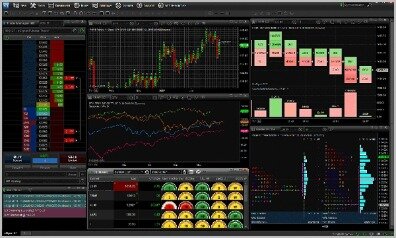
A bull market (aka a bull run) is a long, extended period in the market when overall stock prices are on the rise. A retracement is a brief period in which the general trend in a security’s price is reversed. Even during a bull market, it’s unlikely that stock prices will only ascend.
It is used by attaching a lead rope either directly to it or running through it from a head collar, or for more difficult bulls, a bull pole (or bull staff) may be used. This is a rigid pole about 1 m (3 ft) long with a clip at one end; this attaches to the ring and allows the bull both to be led and to be held away from his handler. Bulls are optimistic investors who are attempting to profit from the upward movement of stocks, with certain strategies suited to that theory. These examples are programmatically compiled from various online sources to illustrate current usage of the word ‘bullock.’ Any opinions expressed in the examples do not represent those of Merriam-Webster or its editors. Because it’s impossible to tell when a market has reached its top from a ground-level perspective, it’s very difficult to foresee the turning point before you are in it.
A male bovine — or cow — is a bull, and so is a male whale or elephant. Fittingly, the word bull is sometimes also used for a particularly bulky, muscular man. Another informal and slightly obscene meaning is “ridiculous,” or “not true,” as when you tell a lie and your brother rudely replies, “Bull!” This slang meaning has its roots in the Old French bole, “deception or trick.” An aggressive bull may be kept confined in a bull pen, a robustly constructed shelter and pen, often with an arrangement to allow the bull to be fed without entering the pen.
It can be tempting to go all-in on a hot stock or sector when the market has been growing, but the end may be closer than you think. If you’ve only bought the biggest so-called winners, you may find that their pumped-up prices evaporate the quickest. A super-strong bull market can make even weak companies appear like sure things — until they aren’t. Be sure you know what it means to diversify effectively, and keep in mind that knee-jerk reactions to news about individual stocks or companies aren’t the best way to figure out where to invest. This record-breaking bull market lasted 131.4 months (nearly 11 years), making it the longest in history. After taking a beating during the Great Recession (2007 to 2009), the S&P 500 gained over 400% after a low of 666 points on March 6, 2009.
Collocations with bull
After the October 2022 low point, the stock market was able to recover some of its losses in the fourth quarter. Others point to Shakespeare’s plays, which make reference to battles involving bulls and bears. In “Macbeth,” the ill-fated titular character says his enemies have tethered him to a stake but “bear-like, I must fight the course.” In “Much Ado About Nothing,” the bull is a savage but noble beast. Adam Hayes, Ph.D., CFA, is a financial writer with 15+ years Wall Street experience as a derivatives trader. Besides his extensive derivative trading expertise, Adam is an expert in economics and behavioral finance.
While there are many different ideas on how the term bull market came to be, it’s generally believed that it comes from how a bull attacks. A bull thrusts its horns upward when it attacks, so the term was adapted to describe stock market growth. During a bull market, there are several characteristics that can be observed.
How leaders can use intuition and reason to be successful – Fast Company
How leaders can use intuition and reason to be successful.
Posted: Sun, 14 May 2023 09:30:00 GMT [source]
Adam received his master’s in economics from The New School for Social Research and his Ph.D. from the University of Wisconsin-Madison in sociology. He is a CFA charterholder as well as holding FINRA Series 7, 55 & 63 licenses. He currently researches and teaches economic sociology and the social studies of finance at the Hebrew University in Jerusalem. These examples are programmatically compiled from various online sources to illustrate current usage of the word ‘bull.’ Any opinions expressed in the examples do not represent those of Merriam-Webster or its editors. Unfortunately, the Nasdaq crashed nearly 80% over the following several months, essentially giving back all of the gains made during the bull run. But just a month later, on March 11, the Dow lost over 20% of its value, falling to under 19,000.
These include an increase in trading volume, as more investors are willing to buy and hold onto securities in the hopes of realizing capital gains. Securities in a bull market also tend to receive higher valuations, as investors are willing to pay more for them due to the perceived potential for price appreciation. There is no specific and universal metric used to identify a bull market.
If an aggressive bull is allowed to graze outside, additional precautions may be needed to help avoid him harming people. One method is a bull mask, which either covers the bull’s eyes completely, or restricts his vision to the ground immediately in front of him, so he cannot see his potential victim. Another method is to attach a length of chain to the bull’s nose-ring, so that if he ducks his head to charge, he steps on the chain and is brought up short.
The longest stock market bull run lasted for 11 years—it started in March 2009 in the wake of the Great Recession and ended in March 2020 when the Covid-19 pandemic shut down the global economy. The longest bull market in the history of the S&P 500 index lasted from March 2009 to February 2020 and saw the index gain over 300%. This bull market was characterized by strong earnings growth, low interest rates, and investor optimism. Despite its length, the bull market was relatively volatile, with several corrections and pullbacks along the way. The technology sector significantly outperformed the broader market during this bull market. In larger pastures, particularly where a bull is kept with other cattle, the animals may simply be fed from a pickup truck or tractor, the vehicle itself providing some protection for the humans involved.
Characteristics of Bull Markets
Rather, there are likely to be shorter periods of time in which small dips occur as well, even as the general trend continues upward. But it always does, after an external force affects investors’ feelings about the future and stock prices start to look too pricey. Technically speaking, a bull market is defined as a 20% gain or more in a stock market index or an individual security. Contrast this with a bear market, which is a 20% or greater loss in a given market or security. Bull markets often exist side-by-side a strong, robust, and growing economy. Stock prices are informed by future expectations of profits and the ability of firms to generate cash flows.
- After taking a beating during the Great Recession (2007 to 2009), the S&P 500 gained over 400% after a low of 666 points on March 6, 2009.
- The term “bull market” is most often used to refer to the stock market but can be applied to anything that is traded, such as bonds, real estate, currencies, and commodities.
- The overall demand for stocks will be positive, along with the overall tone of the market.
- When the stock market experiences a prolonged downturn, it’s called a bear market.
Companies that sell products directly to consumers (as opposed to industrials) have proven themselves over decades. Bull markets in recent years have tended to be powered by such companies, but more importantly, they may be a decent safe harbor during downturns as well. Consider investing in these equities, or in a large-cap mutual fund with such stalwarts. The best investment apps offer a range of investment options (including stocks, bonds, and cryptocurrencies) and market access. Some of the best investment apps for beginners also provide educational resources, research access, and human advisors for low fees.
These are just a few examples of some of the biggest bull markets in history. There have been many others, each with its own unique set of circumstances and drivers. Perhaps the most aggressive way of attempting to capitalize on a bull market is the process known as full swing trading. Investors utilizing this strategy will take very active roles, using short-selling and other techniques to attempt to squeeze out maximum gains as shifts occur within the context of a larger bull market. Aside from their reproductive duties, bulls are also used in certain sports, including bullfighting and bull-riding.
Chambers 20th Century DictionaryRate this definition:0.0 / 0 votes
With dollar cost averaging, you invest a fixed amount of money into a security or securities at set intervals. In many areas, placing rings in bulls’ definition bull noses to help control them is traditional. The ring is usually made of copper, and is inserted through a small hole cut in the septum of the nose.
- The ring is usually made of copper, and is inserted through a small hole cut in the septum of the nose.
- Because it’s impossible to tell when a market has reached its top from a ground-level perspective, it’s very difficult to foresee the turning point before you are in it.
- In the off season, multiple bulls may be kept together in a “bachelor herd”.
- In order to identify bullish stocks, there’s no substitute for learning the ins and outs of technical analysis.
- Some of the best investment apps for beginners also provide educational resources, research access, and human advisors for low fees.
Another famous example of a bull market was the extreme run-up in U.S. housing prices in the mid-2000s. It was fueled by easy-money policies, relaxed lending standards, rampant speculation, unregulated derivatives, and irrational exuberance. If you are bullish on the S&P 500, you attempt to profit from a rise in the index by going long. Bears, however, are pessimistic and believe that a particular security, commodity, or entity is set to suffer a decline in price. By spreading investments across different asset classes, sectors, styles, and geographic regions, investors can still remain bullish without putting too many eggs in one basket. But experts are still mixed on what the rest of the year could look like.
Bull Is Also Mentioned In
On February 12, 2020, the Dow Jones Industrial Average reached a record high of 29,551 points. The gains for the S&P alone amounted to over $18 trillion on paper, and during the period unemployment was at a 40-year low, at under 4%. But one common rule of thumb is a 20% stock price increase from the most recent low, with signs that prices will continue to grow. For example, you might invest $100 weekly, regardless of what the stock market is doing. By doing this, you’re buying more shares when the price is low and fewer shares when the price is high.

Better to enter and leave the market gradually, without drama — or according to your own preset benchmarks — rather than selling all at once because you’re convinced the market has reached its top. If you follow a buying strategy like dollar-cost averaging, stick to it. However, as spending and production increase, the prices of goods and services can inflate.
Alternatively, the bull may be hobbled, or chained by his ring or by a collar to a solid object such as a ring fixed into the ground. Bull investors must be mindful of https://trading-market.org/ what is commonly known as bull traps. Bullish investors identify securities that are likely to increase in value and direct available funds toward those investments.

The thinking behind this strategy is that, presuming that the bull market continues, the price of the security in question will quickly move back up, retroactively providing the investor with a discounted purchase price. Increased buy and hold is a variation of the straightforward buy and hold strategy, and it involves additional risk. The premise behind the increased buy and hold approach is that an investor will continue to add to their holdings in a particular security so long as it continues to increase in price. One common method for increasing holdings suggests that an investor will buy an additional fixed quantity of shares for every increase in the stock price of a pre-set amount.
A strong production economy, high employment, and rising GDP all suggest profits will continue to grow, and this is reflected in rising stock prices. Low interest rates and low corporate tax rates also are positive for corporate profitability. Bull markets are characterized by optimism, investor confidence, and expectations that strong results should continue for an extended period of time. It is difficult to predict consistently when the trends in the market might change. Part of the difficulty is that psychological effects and speculation may sometimes play a large role in the markets. Colloquially, people unfamiliar with cattle may also refer to steers and heifers as “cows”, and bovines of aggressive or long-horned breeds as “bulls” regardless of sex.
Generally, bulls kept with cows tend to be less aggressive than those kept alone. In herd situations, cows with young calves are often more dangerous to humans. In the off season, multiple bulls may be kept together in a “bachelor herd”. Bullish stocks are typically defined as stocks that display a bullish price pattern. In order to identify bullish stocks, there’s no substitute for learning the ins and outs of technical analysis. Always be on the lookout for early signs that a bull run may be coming to an end.